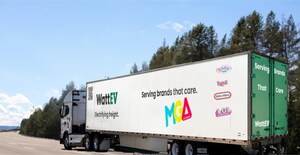WattEV to open nation's largest heavy-duty truck charging depot at Port of Long Beach the week of May 15
Public charging depot features 5MW capacity for concurrent charging of 26 trucks at up to 360KW each
ANAHEIM, Calif., May 4, 2023 /PRNewswire/ -- Electric transportation developer WattEV announced today that construction of its 26-truck charging plaza at the Port of Long Beach – the largest public truck charging station in the nation – is completed and scheduled to open for public use the week of May 15.
The truck charging plaza's public opening will follow a charging infrastructure event – the VOLTS conference – taking place May 9-10 in Long Beach sponsored by the California Energy Commission, hosted by Charging Interface Initiative North America (CharIN Inc.), with testing provided by WattEV.
WattEV announced the Long Beach station opening during the annual Advanced Clean Transportation (ACT) Expo industry conference at the Anaheim Convention Center.
The growing population of heavy-duty electric trucks running in and out of the nation's busiest ocean port complex now can charge up at the nation's largest public electric truck charging spot. Branded simply as "WattEV," the depot is located directly adjacent to the Pier-A terminal in the Port of Long Beach (POLB) and will serve heavy-duty electric trucks with routes connecting to inland destinations throughout Southern California.
The WattEV facility will support the first batch of 14 Nikola electric trucks that will operate on WattEV's zero-emission fleet-transportation platform. The fleet is expected to expand to more than 100 electric trucks by the end of 2023, with the opening of additional charging depots in Southern California.
The current WattEV fleet will haul freight daily from the POLB to warehouses as far away as Hesperia, some 94 miles in distance.
Salim Youssefzadeh, Chief Executive Officer of WattEV, said the POLB charging depot is designed to serve electric truck operations throughout the San Pedro Bay ports complex, and is the first of several WattEV electric truck charging depots in the works throughout California, including warehouse districts in nearby Gardena and inland near San Bernardino.
"This charging station is the southern anchor of our planned electric-truck charging freight corridor, which will incrementally connect to all the major freight routes throughout California, Oregon, Arizona and Nevada," Youssefzadeh said.
The new charging depot will serve WattEV's fleet of electric trucks and other fleets electrifying their trucking operations to and from the combined ports of Long Beach and Los Angeles, which receive some 40 percent of the nation's containerized imports.
Combined, the ports have some 20,000 trucks in their registries using combustion engines, more than 25 percent of which are older than 10 years. Both ports have been setting clean air goals for nearly two decades with a goal of having 100 percent zero-emission trucks serving the ports by 2035.
"Our truck-charging depot at the Port of Long Beach is a major step towards enabling transporters to transition to zero-emission trucking," Youssefzadeh said.
On opening, WattEV's POLB e-truck charging plaza will feature 26 charging bays using Combined Charging System (CCS) connectors to provide power at up to 360 kilowatts. The CCS system is the current charging standard for heavy-duty electric trucks, while faster charging systems are under development.
When trucks with megawatt charging capability become available, four more pass-through e-truck bays are planned at the POLB charging plaza, featuring the faster, higher-power Megawatt Charging System (MCS), rated for charging at up to 1.2 megawatts.
The MCS is expected to become the worldwide standard for fast charging of medium and heavy-duty commercial vehicles, reducing typical charge sessions to less than 30 minutes. WattEV has a prototype of an MCS charger on display in its ACT Expo booth # 5815.
About WattEV
WattEV's mission is to accelerate the transition of U.S. trucking transport to zero emissions. It uses a combination of business and technology innovations to create charging infrastructure and data-driven workflow that provide truckers and fleet operators the lowest total cost of ownership. WattEV's goal is to get 12,000 heavy-duty electric trucks on California roads by the end of 2030, exceeding existing forecasts. More information is available online at www.WattEV.com.
SOURCE WattEV

WANT YOUR COMPANY'S NEWS FEATURED ON PRNEWSWIRE.COM?
Newsrooms &
Influencers
Digital Media
Outlets
Journalists
Opted In






Share this article